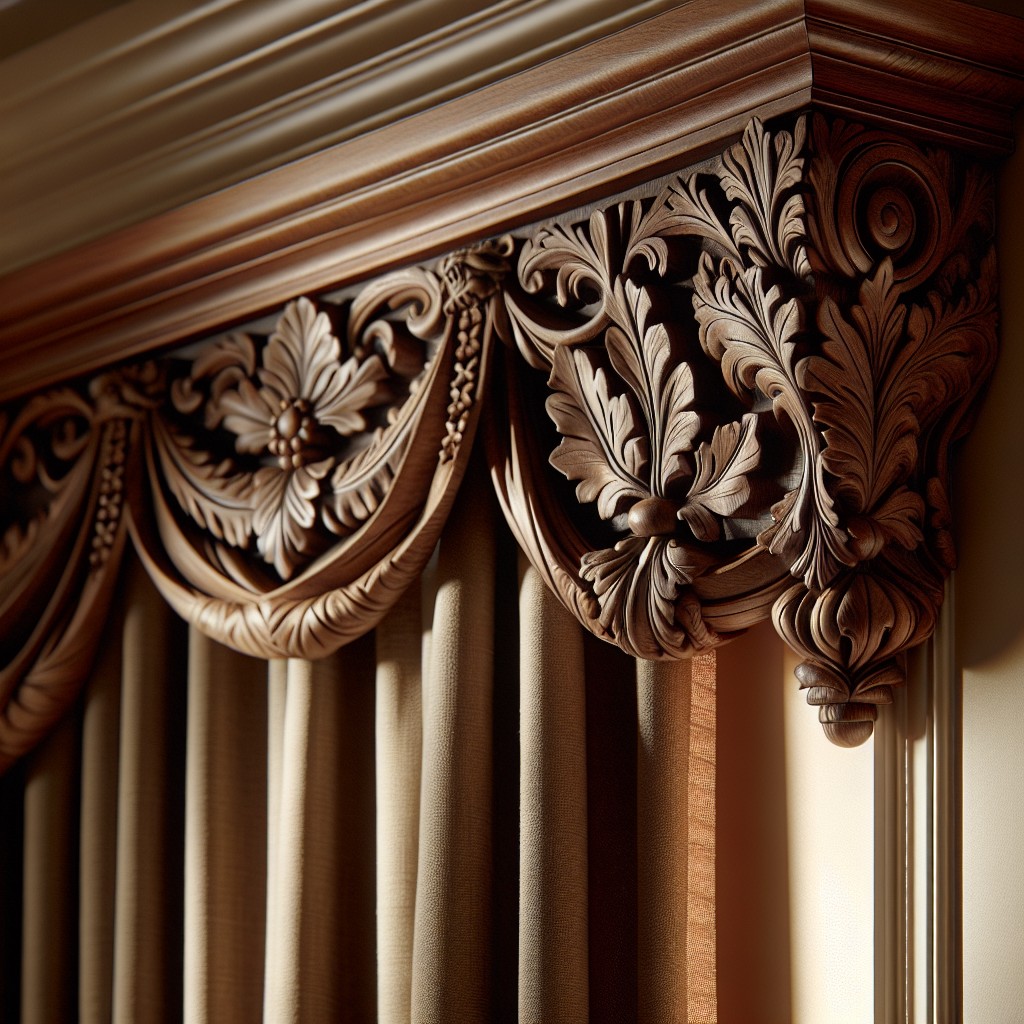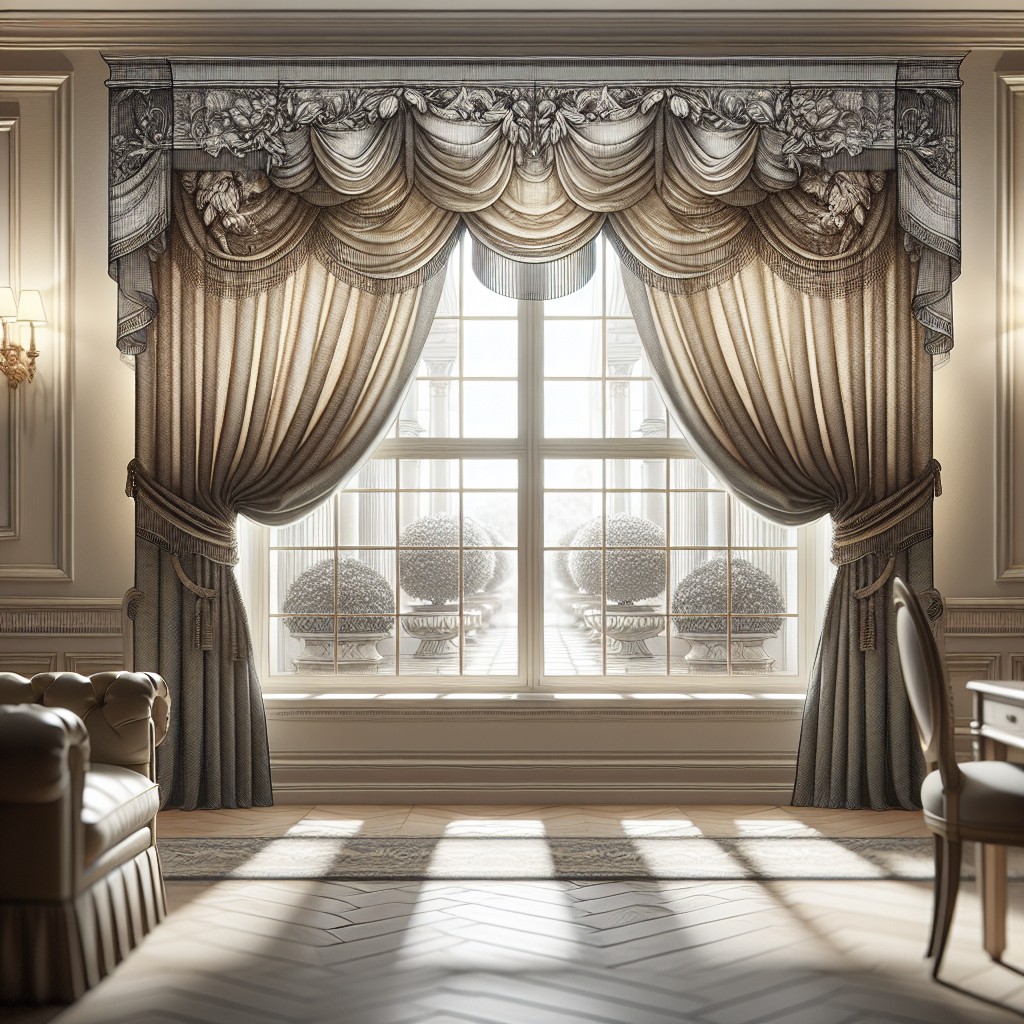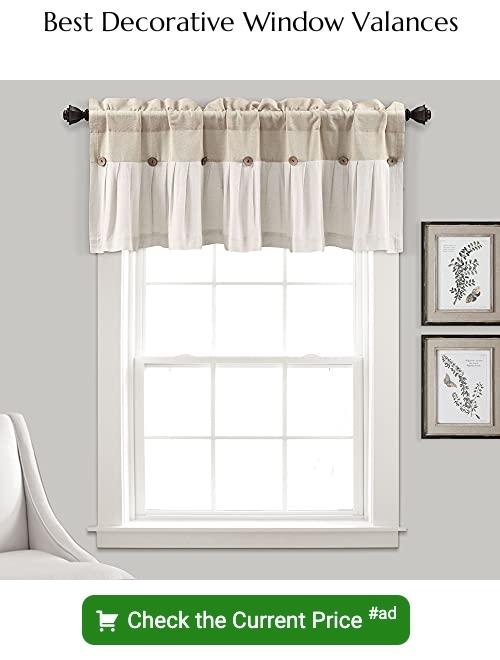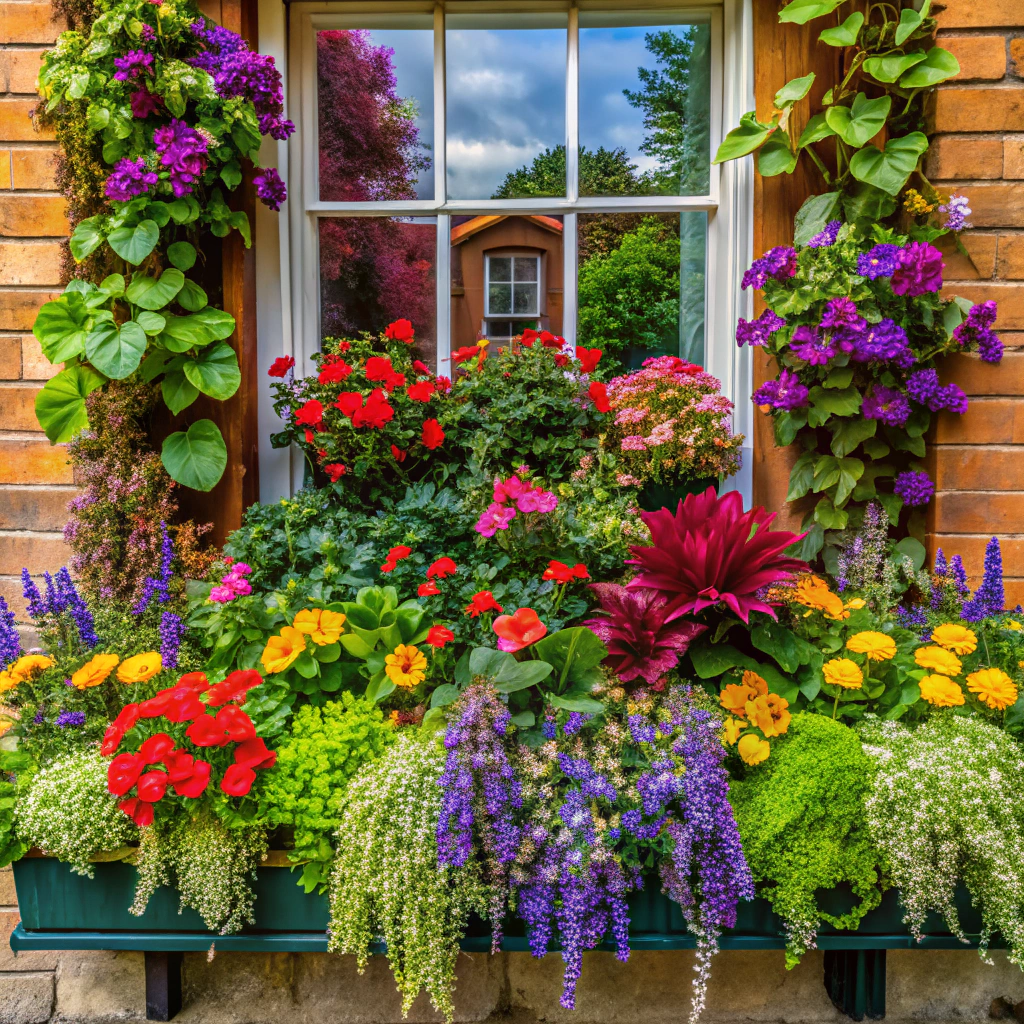Dive into the world of valance returns because these decorative window treatments can significantly enhance the aesthetics and increase the value of your home.
Key takeaways:
- Valance returns block light, provide insulation, and add privacy
- Inside-mount and outside-mount returns are common types
- Valance returns can be made of wood, fabric, foam board, or metal
- Measure accurately for valance returns to ensure a snug fit
- Returns are important for custom valances and various valance styles
Definition of Valance Return

A valance return is an extension of the valance fabric or structure that covers the side brackets or ends of the drapery hardware, creating a cohesive look. It serves to block the gap between the valance and the wall, preventing light from seeping through and offering a polished appearance.
Valance returns are particularly useful when the window treatment needs to appear continuous around the sides and when privacy or light control is a concern. They are measured from the front face of the valance to the wall, ensuring a snug fit that aligns with the depth of the drapery hardware used.
Function of Valance Returns On Window Treatments

Valance returns serve several key roles in enhancing window dressings:
- They conceal the mounting hardware of the window treatment, creating a clean and seamless look from any viewing angle.
- Their extension from the valance back to the wall also blocks light from seeping through the sides, offering better light control.
- Returns add a three-dimensional quality to window treatments, giving them a richer and more substantial appearance.
- They contribute to the insulation of the window by trapping air, which can help in maintaining room temperature.
- By covering the side gaps, returns provide additional privacy, a feature particularly appreciated in bedrooms and living areas.
- They offer a finished touch to the aesthetic of a room, complementing both the window treatment and overall décor.
Types of Valance Returns
Valance returns can vary significantly, each designed to complement the style of the window treatment and the room’s overall aesthetics. Returns are the segments of a valance or top treatment that extend from the front edge back to the wall, creating a finished look.
- Inside-mount returns: These tuck into the window recess, connecting the valance to the window frame for a clean, built-in appearance, ideal for when the window treatment is inside the window opening.
- Outside-mount returns: Suitable for when the valance extends beyond the width of the window, these connect the edges of an overhanging valance to the wall, covering the mounting hardware and providing a polished finish.
- Fabric returns: Generally found on soft valances, these returns are fabric extensions that continue the pattern and flow seamlessly from the front.
- Wood returns: Often seen on cornices or board-mounted valances, these are typically painted or stained to match the front panel, giving a structured, cohesive look.
The depth of the return usually matches the projection of the window treatment hardware, ensuring a unifying design that encases the top of the window uniformly.
Materials Commonly Used for Valance Returns
Valance returns can be crafted from an array of materials to match or complement the primary valance fabric. Wood is a popular choice for structured looks, providing stability to board-mounted valances. It can be painted or stained to coordinate with the room’s decor.
Fabric is another commonly used material, offering a soft and continuous look from the valance front to the sides. Sturdier fabrics like upholstery material can sustain the shape of the return without sagging over time.
Foam board is a lightweight alternative, favored for its ease of cutting and installation. It can be upholstered with fabric to blend seamlessly with the rest of the window treatment.
For a luxurious touch, metal returns in finishes like brass, bronze, or nickel add an elegant edge to more opulent designs, though these are less common.
In terms of practicality, synthetic materials such as plastic or PVC are sometimes used for their durability and ease of maintenance, especially in moisture-prone areas like kitchens and bathrooms. These materials can be fashioned to mimic more traditional looks, such as wood, but often at a lower cost and with greater resistance to warping or rotting.
Ultimately, choosing the right material for valance returns hinges on the desired aesthetic, the level of durability needed, and the overall design of the window treatment.
Measuring for Valance Returns
To measure for valance returns accurately, follow these straightforward steps:
1. Determine the Mounting Depth: Measure the wall area that will accommodate the valance. Ensure there’s enough depth to mount the valance without obstructing the window’s functionality.
2. Assess the Bracket Protrusion: Measure how far in front of the window frame any existing or planned brackets stick out. This will guide the length of your return.
3. Calculate Return Length: The return length should cover the bracket or mounting hardware completely. Add an extra inch for a seamless look that aligns with the front of the valance.
4. Consider Valance Width: If the valance extends across the window frame, factor in additional width, ensuring that returns do not squeeze the drapery or interfere with window operation.
5. Check for Obstructions: Look for any potential interference—handles, locks, or moldings—that may affect the return and adjust measurements accordingly.
Use a metal tape measure for precision and note down the figures. Correct measurements ensure that valance returns fit snugly and give your window treatments a polished appearance.
Installation of Valance Returns
Effective installation of valance returns ensures a professional and polished appearance to your window treatments. Here’s a step-by-step guide to secure your valance flawlessly:
1. Align the Brackets: Begin by positioning the brackets that will support the valance. Ensure they are level and at the correct depth to accommodate the return.
2. Attach the Brackets: Secure each bracket to the wall or window frame with screws. Double-check their stability – a wobbly bracket could lead to an uneven valance.
3. Prepare the Valance: If your valance has a separate return piece, attach it to the main valance structure. Some valances come with an integrated return, so check your specific model.
4. Mount the Valance: Carefully lift the valance and slide the returns onto the brackets. This may require an extra set of hands for stability and alignment.
5. Adjust for Fit: Once in place, make slight adjustments to ensure the valance is straight, centered, and flush against the wall.
6. Secure the Structure: Some valance designs may require additional fasteners or ties to firmly secure the return to the wall, preventing gaps or sagging.
7. Inspect and Tidy: Take a step back and inspect your handiwork from different angles. Make any necessary tweaks and tidy up any tools or hardware.
Remember, precision is key. Measure twice, install once, and cherish the beautiful results your craftsmanship yields.
Custom Valances and the Importance of Returns
Custom valances elevate a room’s aesthetic, turning windows into works of art. The role of valance returns cannot be overstated when striving for a well-tailored look. Returns—extensions of the valance that cover the sides of the rod or mounting board—create a polished finish by hiding the hardware from side views.
Here’s why they’re indispensable:
- Consistency: They ensure the valance’s fabric and design seamlessly continue around the window’s sides, maintaining design consistency.
- Aesthetics: By covering hardware, returns contribute to an uninterrupted visual flow, enhancing the custom valance’s elegance.
- Insulation: Returns can slightly improve thermal insulation and light control by blocking drafts and light leaks around the window’s edges.
For custom valances, it’s critical to factor in the return measurement during the design phase to harmonize with the overall window treatment.
Balloon and London Valances: Utilizing Returns
Balloon and London valances present a soft, gathered look that can shift from casual to elegant depending on the fabric used. These styles are particularly well-suited for more traditional or romantic room aesthetics.
Employing returns on these valances ensures that the sides and corners where the valance meets the wall are draped uniformly, maintaining visual continuity around the window casing. This detail tends to conceal the mounting hardware and provides a cohesive look from the side angle, giving the window a polished appearance.
Properly measured and installed, returns enhance the overall fullness and body of the valance, ensuring that the gathered fabric maintains its intended shape and elegance from every viewpoint.
Board-Mounted Valances: Achieving a Finished Look With Returns
Board-mounted valances are a sophisticated window treatment option offering a structured, tailored appearance. The key to their refined look lies in the use of valance returns. Returns are the segments of fabric or material that extend from the ends of the valance back to the wall, creating a cohesive visual flow and concealing the mounting hardware.
Here’s why returns are essential for board-mounted valances:
- They provide a clean, polished edge that frames the window, delivering a custom-fitted finish.
- Returns hide the side view of the curtain rod or mounting board, preventing an incomplete or disjointed appearance from the room’s side angles.
- When paired with other window treatments like blinds or shades, returns give the illusion of a continuous line, enhancing the overall aesthetic.
- They serve as insulation, blocking slight drafts that may come from the window’s sides, thus contributing to energy efficiency.
To ensure a perfect fit, measure the depth of the window frame or current window treatments to determine the appropriate length for the return. Then, you can tailor the valance to the specific dimensions, guaranteeing the finished product appears intentional and professionally installed.
Flat and M-Shaped Valances: The Role of Returns
Flat and M-shaped valances are favored for their clean lines and simple elegance. Returns are integral as they conceal the mounting hardware and the side view of the headrail, providing a neat, cohesive appearance from all angles.
For flat valances, returns create a polished edge, ensuring the window treatment looks finished. The fabric seamlessly wraps around to the wall, eliminating gaps that would detract from the design.
In M-shaped valances, returns maintain the design’s symmetry and keep the pattern uninterrupted. They allow the distinctive dips and peaks of the M-shape to stand out while still covering the hardware and the sides of the blind or shade beneath.
To achieve the best results, the return size should match the depth of the window treatment’s mounting brackets, ensuring a snug fit against the wall. Additionally, lining the returns with the same fabric as the valance maintains consistency and blocks light from the sides.
Rod Pocket Valances: Returns for Seamless Design
Rod pocket valances exemplify classic simplicity, gracefully sliding onto the rod for an effortless look. The inclusion of returns offers a cohesive design wrapping around the sides to conceal mounting hardware, providing a neat finish.
For a seamless appearance:
- Ensure the return’s width matches the space between the valance sides and the wall. This alignment keeps the visual flow uninterrupted.
- The rod should extend slightly beyond the width of the window, allowing the valance fabric to cover the window frame completely when returns are used.
- Match the rod pocket size to the diameter of the rod, factoring in a bit of additional space for smooth movement across the rod without bunching.
- Returns that are too short may expose brackets, while overly long returns create bulging and disturb the valance drape.
- For rods with finials, adjust the length of your returns to accommodate and create a tailored look reflecting the curve or shape of the finials.
A well-executed return on a rod pocket valance can transform a simple window into a polished element of any room’s decor.
Straight Valances: The Necessity of Returns for Finished Edges
When it comes to straight valances, the inclusion of returns is key to creating a polished look. Returns are the portions of the valance that wrap around the sides of the window, extending back to the wall. Here’s why they are essential:
- They conceal the mounting hardware and the side view of the rod, which ensures the window treatment appears complete from all angles.
- Returns provide a continuity of design, so the valance maintains a uniform appearance without gaps.
- They help to block light that might seep through the small spaces between the valance and the wall, contributing to better light control in the room.
- When executed properly, returns give the side edges a clean finish, enhancing the overall aesthetic of your window treatment.
In summary, returns on straight valances are not just a decorative feature but a functional aspect that supports both the design integrity and the effectiveness of the window treatment.
Faux Roman Shade Valances: The Illusion With Proper Returns
Faux Roman shade valances create the sophisticated look of a fully operational Roman shade without the functionality and at a fraction of the cost. The key to their effectiveness lies in the returns:
- Returns enhance the illusion by wrapping around the sides, concealing the mounting hardware for a seamless transition from valance to wall.
- Typically, they should be 3 to 4 inches deep, mirroring the perceived depth of an actual Roman shade.
- They ensure the valance appears uniformly structured from all viewing angles, maintaining the visual deception.
- For outside mounts, returns are critical to cover the sides of blind or shade hardware that might otherwise be exposed.
Correct implementation of returns on faux Roman shades is vital for achieving a polished and authentic window treatment appearance.
Tailed Balloon Swag Valances: The Elegance of Returns
Tailed balloon swag valances add an air of sophistication to any room, with their full, rounded sections and elegantly draping tails. The returns on these valances serve a critical function; they conceal the mounting hardware and side brackets, creating a continuous line from the valance around to the wall. This seamless transition enhances the visual flow, making the window treatment appear more integral to the window itself.
For ideal results:
- Ensure the returns are deep enough to cover the sides of the curtain rod or board. This typically means they should match the projection of the rod.
- The returns should be stiffened to maintain their shape and keep the elegance of the swag consistently presented.
- When using a tailed balloon swag valance without a curtain underneath, pay special attention to the returns as they play a key role in the overall appearance from both inside and outside the home.
Incorporating returns into the design of tailed balloon swag valances is a detail that can transform the look of a room by providing a polished finish.
Day Measuring Insurance: Ensuring Accurate Valance Returns
Understanding the significance of precise measurements for valance returns, many window treatment companies offer a unique service known as 30-Day Measuring Insurance. This service acknowledges the potential for human error during the measurement process and provides a safety net for customers.
- Measuring Insurance allows for a one-time remeasurement and product replacement if initial measurements are incorrect.
- It typically covers the cost of the new product under the condition that errors are reported within 30 days of receipt.
- Customers must adhere to the company’s specific measuring guidelines to qualify for this protection.
- This service is particularly beneficial for intricate or non-standard window shapes where measurement errors are more common.
By opting for Measuring Insurance, customers can confidently order custom valances, knowing they have support if a mistake occurs.
Day Returns: Policy Regarding Returns and Valance Returns
When considering the purchase of valance returns, it’s crucial to understand the return policy should the product not meet your expectations or requirements. Here are some key points about the typical return policies for valance returns:
- Most retailers offer a 30-day return period, providing customers with enough time to assess the product’s fit and appearance.
- Ensure the product is in its original condition; used or altered items may not be eligible for returns.
- Keep in mind that custom valance returns often cannot be returned due to their bespoke nature, unless there is a manufacturing defect.
- To facilitate a smooth return process, retain the original packaging and include all associated hardware or accessories.
- Check if the retailer requires a return authorization number before sending the product back to avoid any confusion or delays.
- Be aware of any restocking fees that may be deducted from your refund, as this varies by retailer.
- Review the retailer’s policy on who is responsible for return shipping costs.
Understanding these points will help ensure a straightforward experience in the unlikely event that a product needs to be returned.
Importance of Returns for Custom Orders
When ordering custom valances, returns can be the difference between a tailored look and an unfinished appearance. Here are key points to consider:
- Customized returns ensure that the valances fit the window’s depth properly, covering the mounting hardware and side gaps for a seamless facade.
- Accurate return measurements contribute to the cohesive flow of the fabric’s pattern, making the transition from front to side visually pleasing.
- The consideration of wall and window dimensions is critical in custom returns to accommodate unique architectural features and obstructions.
- Consistent return size throughout a space maintains a uniform aesthetic, particularly important in rooms with multiple windows or varying window sizes.
- Custom orders with precise returns offer superior light control and privacy, covering angles that might otherwise allow unwanted light or views into the room.
Customizing Returns for Faux Shades
When tailoring returns for faux shades, the primary objective is to preserve the illusion of a functional Roman shade while ensuring the sides are not exposed. To achieve this:
- Evaluate the depth of the window casing where the faux shade will hang. This measurement guides the length of the return.
- Choose a return depth that allows the sides of the faux shade to sit flush against the wall or window frame. This technique masks the non-operational aspect of the shade.
- If mounting hardware is visible, use returns to conceal it, promoting a seamless appearance integral to the faux shade’s aesthetic.
- Consider the fabric thickness. Thicker fabrics may require slightly longer returns to accommodate the additional bulk without distorting the front face of the faux shade.
- For an inside mount, ensure returns are long enough to cover the mounting brackets but short enough not to impede the window’s functionality.
By attentively customizing returns, you can enhance the visual integrity of faux Roman shades, extending their sophistication to any room’s decor.
FAQ
What is a valance return?
A valance return is the additional side pieces attached to a standard valance.
What is a valance return size?
A valance return size refers to the length of the side pieces of an Outside Mount Valance, which can range from 1/2" to 8".
What is a valence on a blind?
A valance on a blind is a decorative window treatment that covers the uppermost part of the window, often used to hide drapery hardware.
How do you measure for valance returns?
To measure for valance returns, measure the distance from the front of the rod to the point where you want the valance to end.
How are valance returns installed on blinds?
Valance returns on blinds are installed by attaching them to the ends of the valance using clips or magnets provided in the blinds kit.
Are valance returns mandatory for all window treatments?
No, valance returns are not mandatory for all window treatments, but they contribute to a finished look especially for certain styles and window types.
Recap




